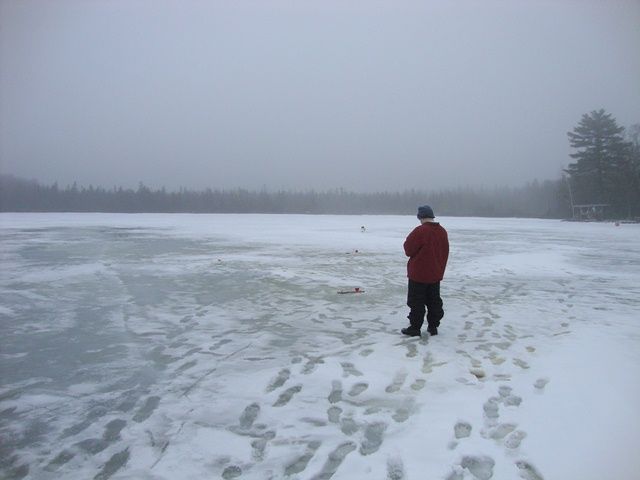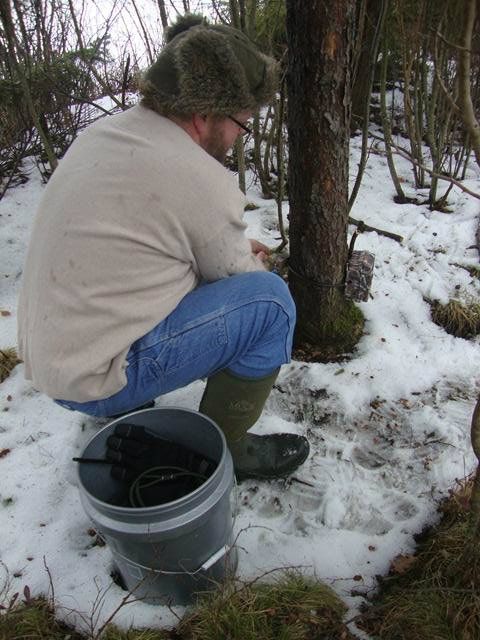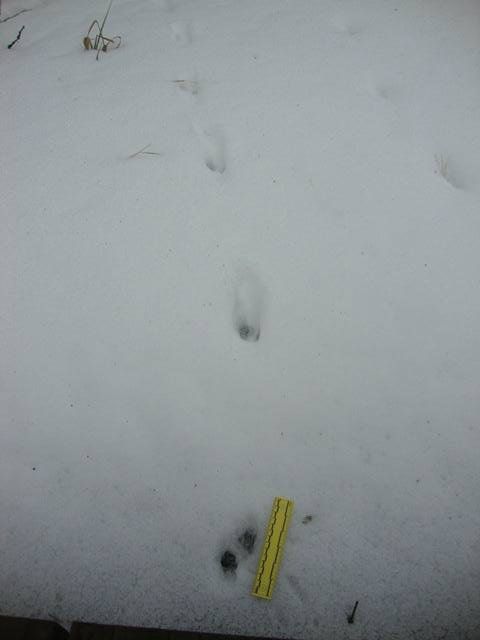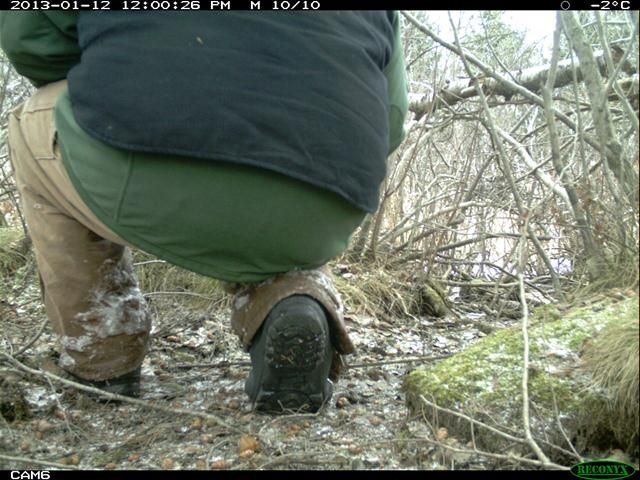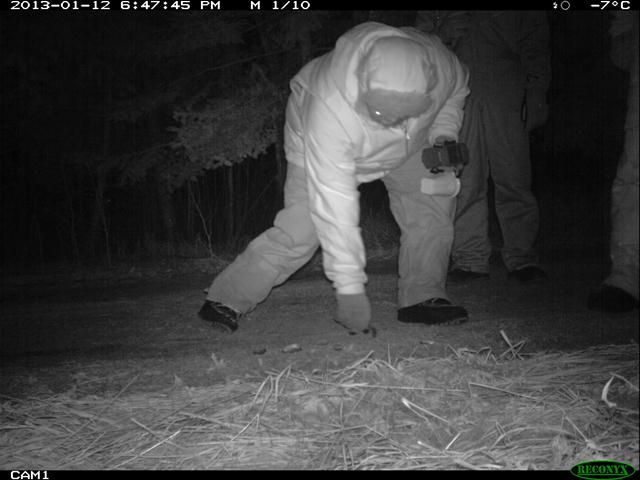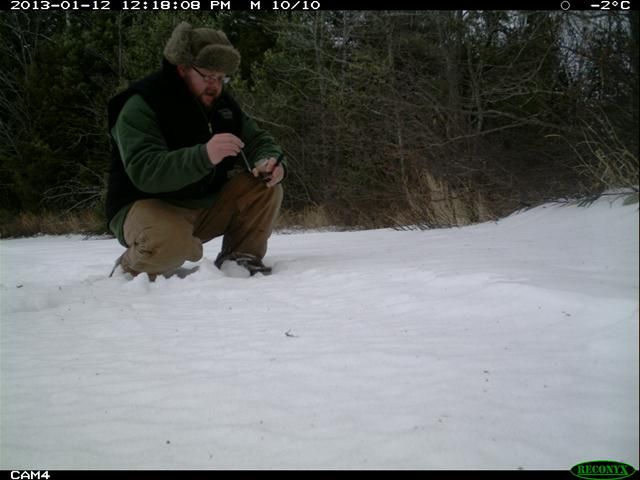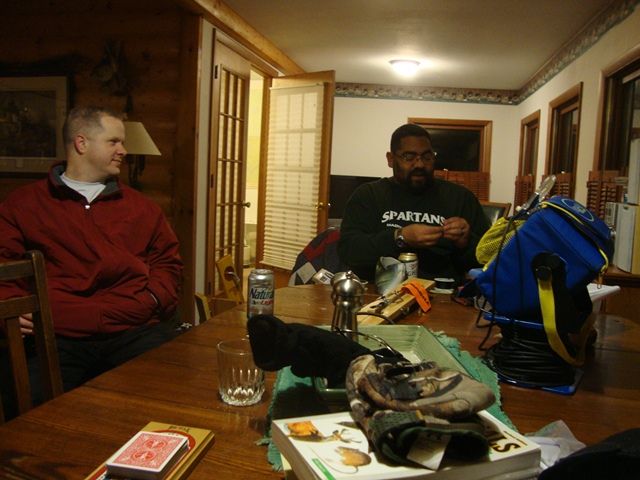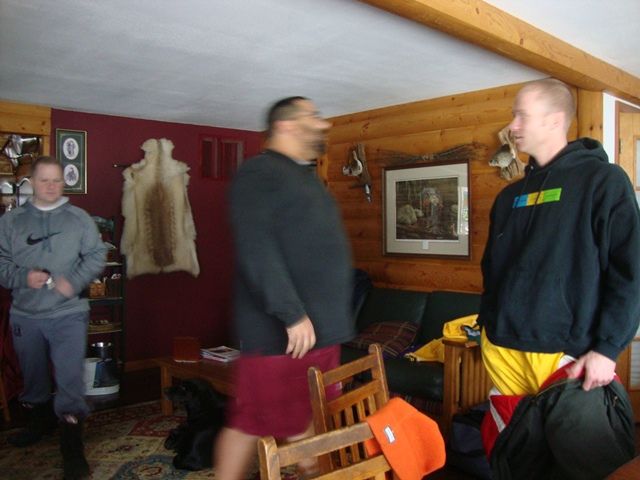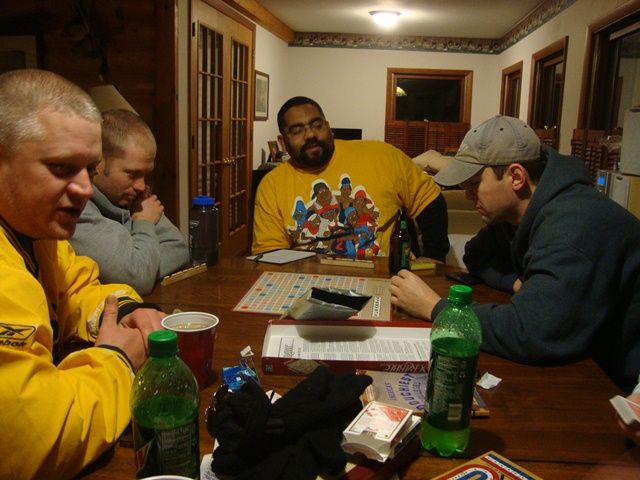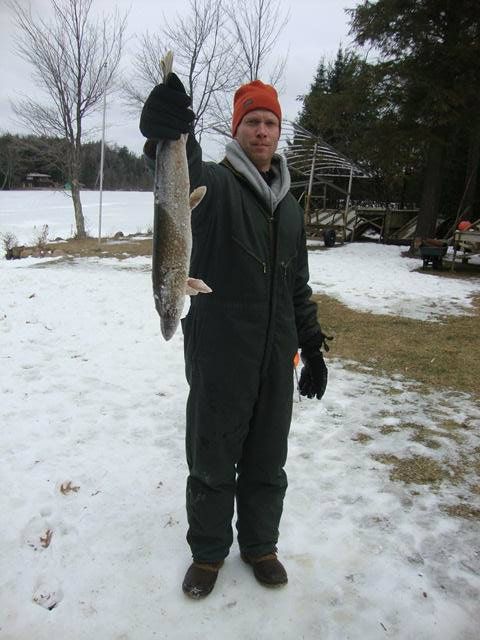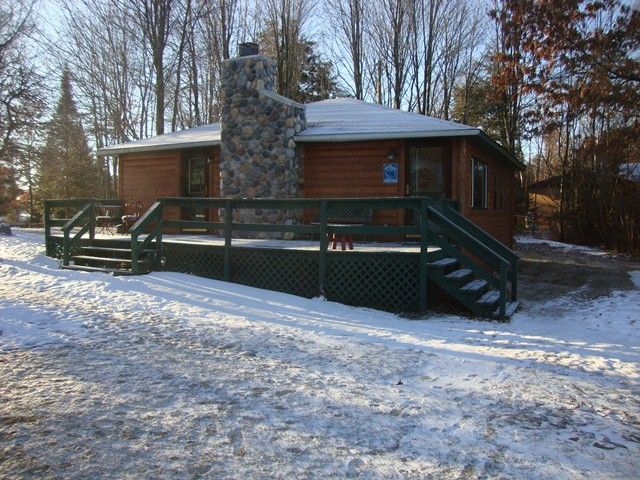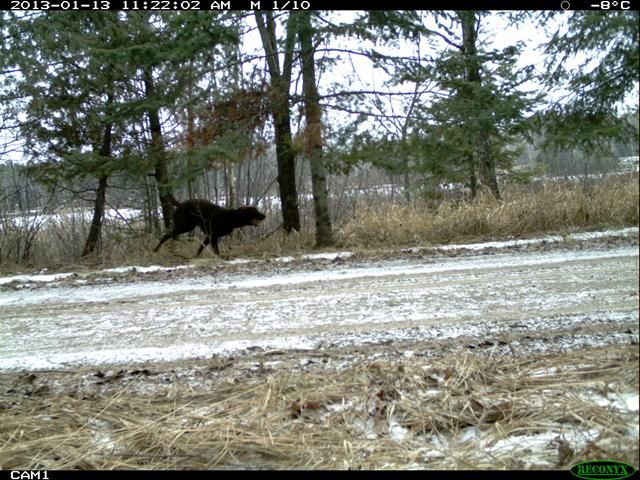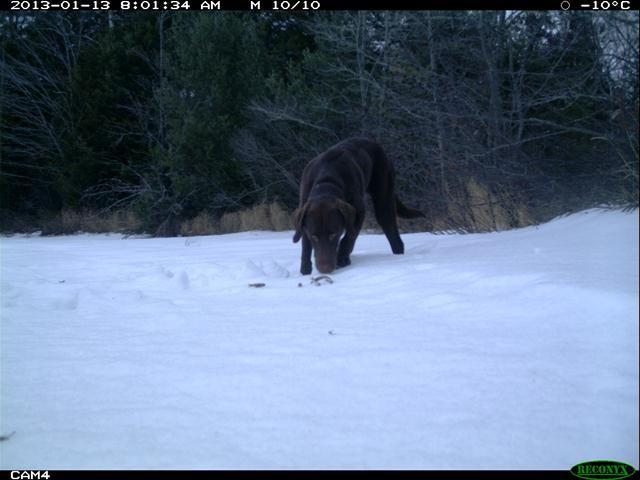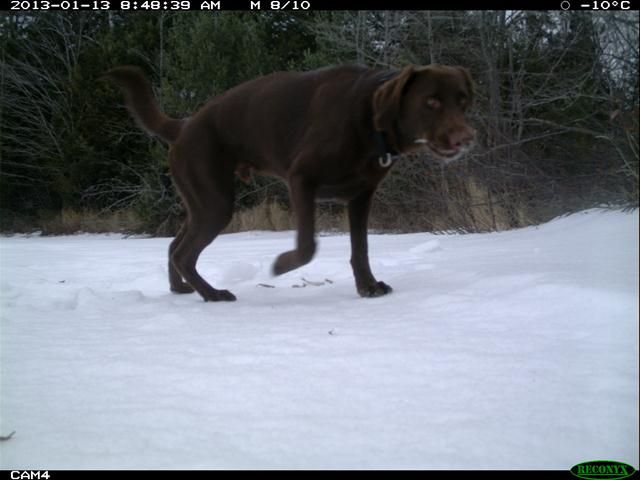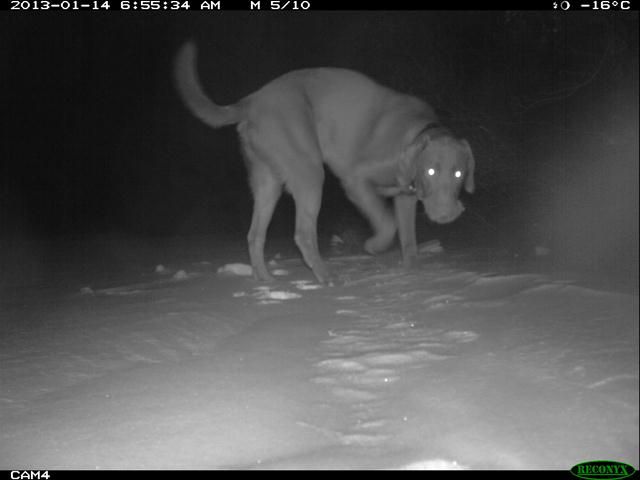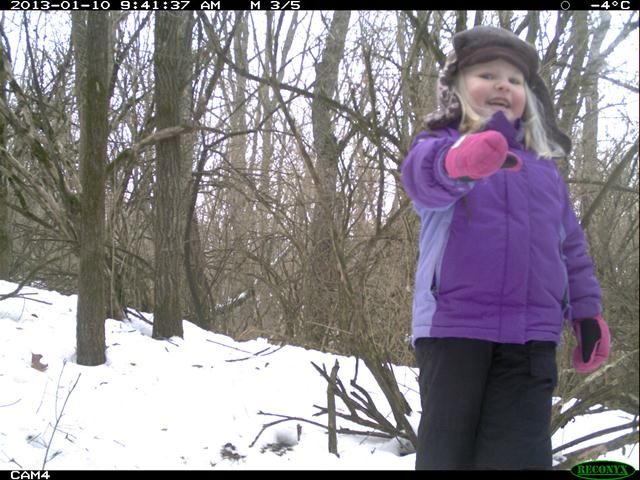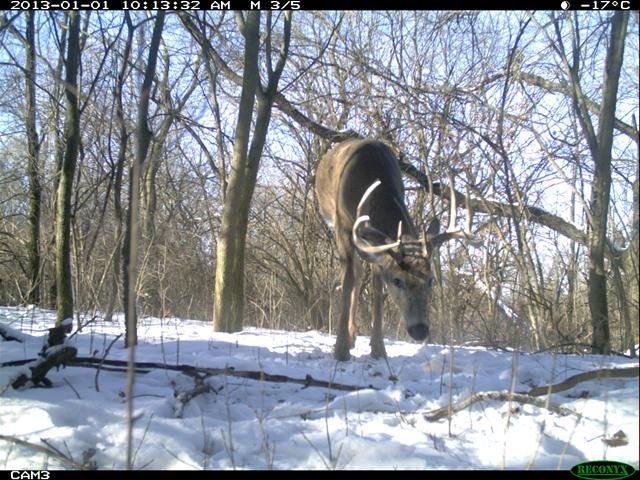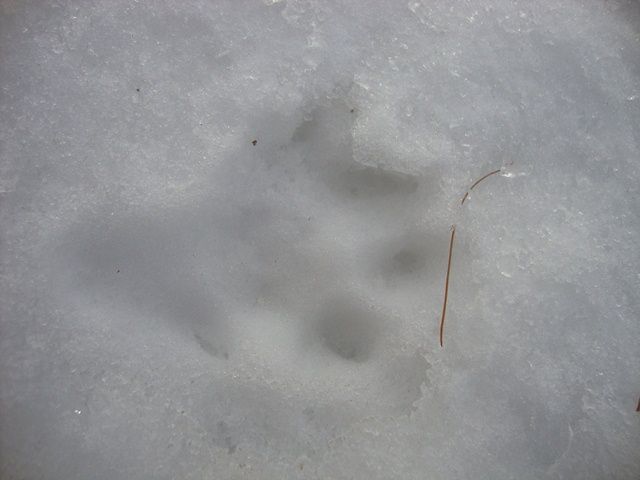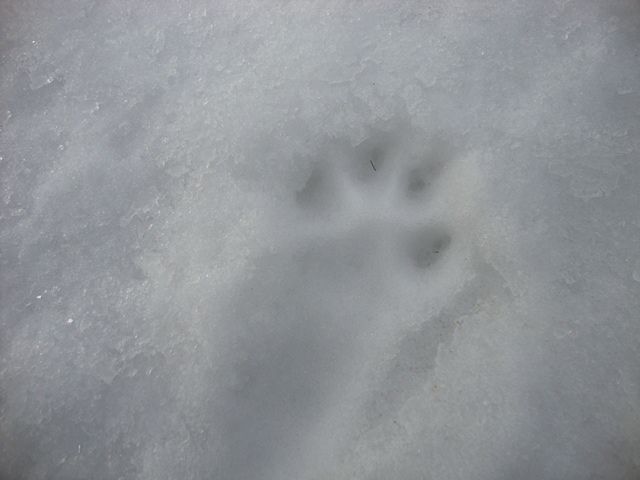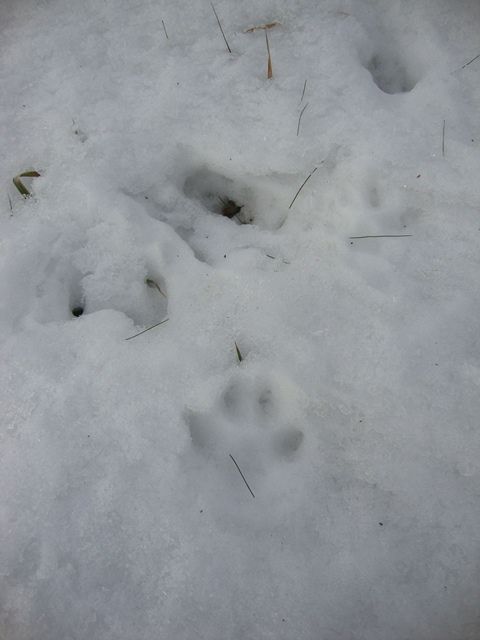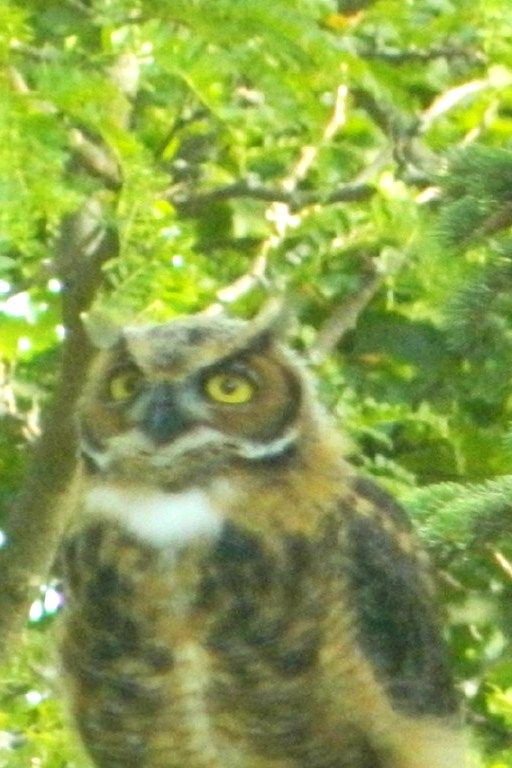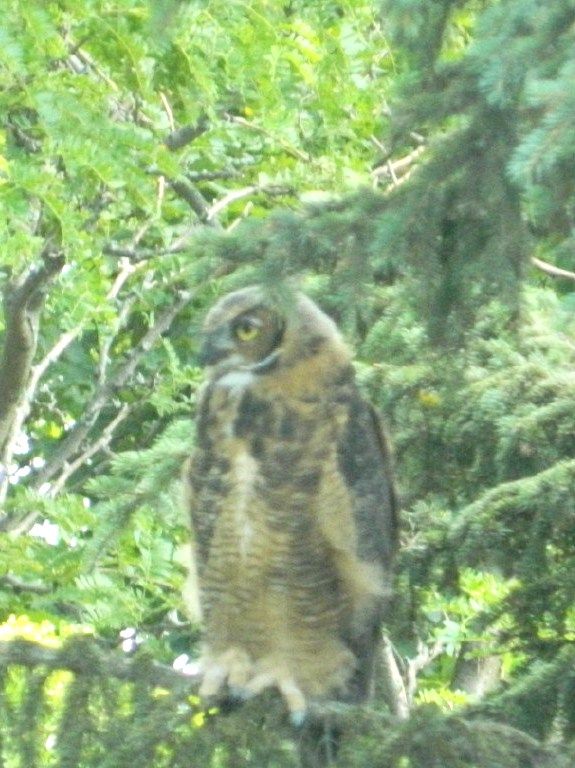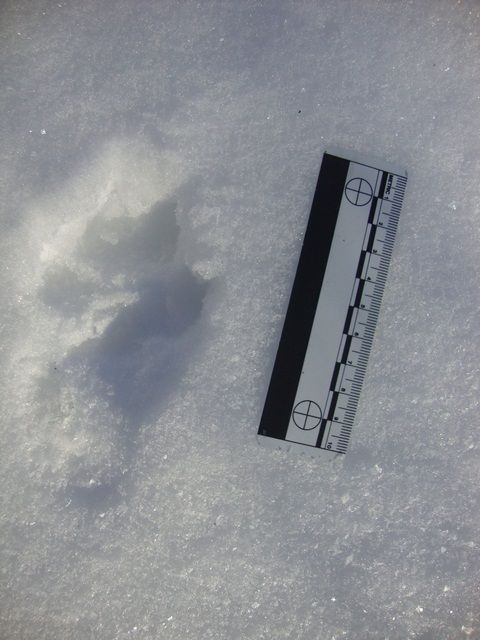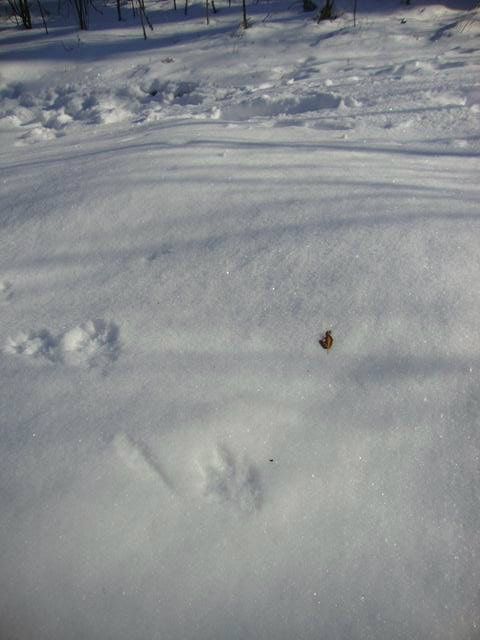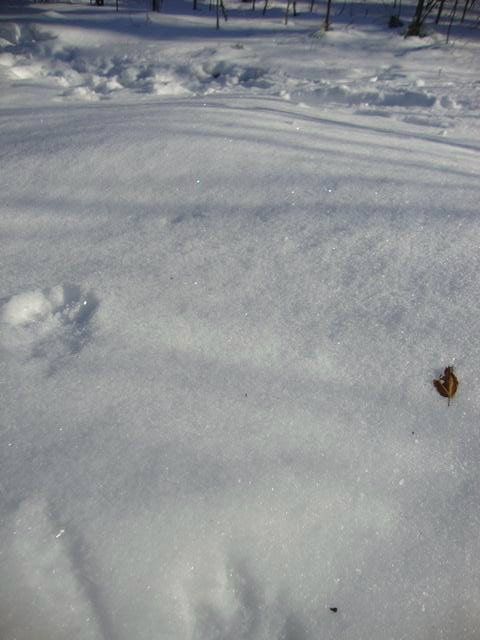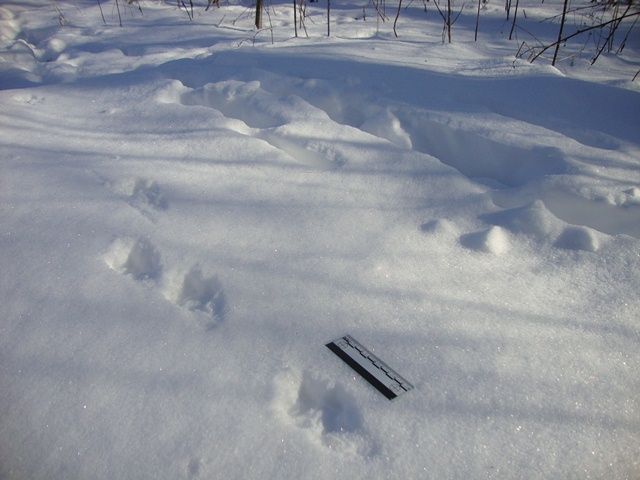The time has come again. The annual ice fishing trip with my high school buddies, which always occurs in January. I've posted about this trip in the past (see
here). It's a great time, filled with laughs, reminiscing....and food (
lots and lots of food). Our friend, Nate, is an outstanding wild-game chef...and we are spoiled by his cooking throughout the weekend. It's always a trip to look forward to.
This year was a strange one, from a standpoint of local climate. We are accustomed to very cold temperatures (-20 to -40 F is not uncommon) and lots of snow.
Justin and I arrived at the cabin early on Friday to a very different state of affairs.
Above: Justin assesses the situation on the ice (note the shorts and sandals)
Temperatures were in the mid-40s....the snow was melting, or had melted, and there was slush on what ice remained over the lake. Shorts and t-shirts were tolerable on-site....at least for a half-hour or so....and then they were only mildly uncomfortable. But...regardless...there was work to do. First, the tip-ups (an important bit of ice fishing gear) had to be gathered for deployment.
Typically, Nate checks all the gear over before we schlep it out onto the ice, but he and the others wouldn't be arriving for several hours. So, Justin and I got to work drilling holes in the ice and setting out some of the tip-ups.
We also took some time to get a few camera traps hung in the woods. I had three available for the task. It's a fun endeavor and based on tracks observed during past trips I know there are weasels, fishers, fox, and bobcats in the area. There's also Wolves that pass through, although they don't exist in as high of densities there as in other parts of the state.
But there was a lot working against the success of the cameras I set out. For example, the short time frame (2 to 3 nights, at maximum). Then, there's the typically harsh weather....which can result in some critters not moving quite as frequently. Also, with such large areas of undeveloped land, there's a lot of space for critters to roam. Thus, they are not concentrated on small patches of suitable habitat, as they are in the more developed and agriculture-dominated landscapes further south. Finally, there's the fact that I don't want to tresspass and have a limited amount of land available to hang cameras in.
Yet, half of the fun is finding spots and hanging cameras.
Above: deploying camera traps. Note the lite long-sleeved shirt and muck boots (not snow boots).
It was warm out there!
I decided to pull out all of the stops again this year. I brought some scent lures, Fox urine and Beaver castor, and an electronic predator caller to deploy with one of the cameras. We also had ample minnows (fishing bait) to put in front of the cams.
Above: "Let ME come to IT" instructed Andy when I asked if he wanted to smell fox urine.
Apparently, there was concern I would shove it in his face. When have I ever...?!
I've always had a soft spot for any members of the family Mustelidae (the weasels, otters, badgers, mink, etc.). So I always try and find spots for weasels or fishers on-site. I've seen their tracks in several of our past years at this location and this year was no different.
Above two pictures: notice the size of the tracks...I'm guessing either a Long-tailed or Short-tailed Weasel (Mustela frenata or M. erminea). Also notice the "dumb-bell" pattern in the trail in the second picture,
created by the weasel's bounding gait.
So, the presence of the weasel tracks confirmed that our first camera location was good. This set was located on a sort of peninsula separating the lake from a small backwater wetland area. I hung the camera on a tree about where two breaks occurred in the trees/shrubs, creating easy paths that crossed between the wetland and the lake's edge. Although I didn't see a large number of tracks...the snow was melting everywhere and I figured it was still a natural corridor. This spot got a dab of beaver castor, smeared on a bit of alpaca wool (for a visual attractant) and a few dead minnows as bait.
Above: camera 1 location, facing the backwater wetland (past the shrubs in the current field of view)
The second location was along the dirt road heading out to the cabin. The cabin itself is on another large peninsula and there is very little vehicle traffic on the road. I always see lots of tracks here and can't resist mounting a camera. This spot received a combination of beaver Castor, fox urine and some minnows.
Above: camera 2 location along the dirt road
The last location was selected based on seeing many tracks in the snow covering the lake in previous years (usually near our fishing holes). I always find fox tracks and see the minnows we have accidentally dropped on the ice getting chewed up by morning. Yet, in the past there has been a constant string of snow mobiles on the lake. These make me nervous. I worry that any camera I leave on the ice will be stolen or run-over.
This year, however, the slushy conditions on the lake were not conducive to snow mobiles. So I felt comfortable enough to put a camera on the ice (strapped to an over-turned 5-gallon pail). I also strapped the speaker for the electronic predator caller on this bucket. The remote control had a range of over 50 yards and I was able to stand on the porch of the cabin and trigger sounds day or night (usually rabbit in distress or a coyote howl). This set also received a bit of fox urine and some bait minnows.
Above: Camera 3 location on day 2. Resting on the ice facing the nearby shore.
It was not long before the others arrived. Nate went through the remaining fishing gear to insure things were in working order.
Above: Nate gives the gear a once over, while Justin helps (apparently)
At roughly 9:30 pm that night....our first fish was caught: a very nice walleye. Not sure why I didn't get a picture of it! But, then the weather grew even more unfriendly, and it misted/rained for most of the evening. This made the conditions on the ice even sloppier.
____________________________________________________________________________
The next morning we awoke to a total slushy mess. There was still 8 to 10 inches of ice over the lake, so it was completely safe. But on top of that ice was a mix of ankle-deep water and melting snow. I quickly discovered it was actually better to wear my muck boots than my snow boots as we drilled holes and deployed the remaining tip-ups.
Above: Justin, Nate and Chad hope for better ice conditions during Day 1 of the trip
That first full-day produced nothing but a few stolen minnows, an average-sized Northern Pike, and a very small walleye (that was promptly returned to the water). Furthermore, the strange weather conditions continued. Over the course of the day, the temperature made complete 180 degree turn and dropped from the 40s down into the teens by that evening. And so it was that we spent the second night waiting....playing Scrabble and cribbage....hoping for better luck on day two.
Above: Andy, Chad, Nate and Dan spend a quiet evening over the Scrabble board
_______________________________________________________________________
The sun rose on a very frigid second morning (hovering around 10 degrees F). The slush upon the ice had frozen into a solid, smooth sheen that was treacherous to walk over. With the drop in temperature, the ice on the lake started to thicken. This resulted in a spectacular (and intimidating) sound that occurs when ice forms over a large area, like a lake. As the ice expands, which happens with extreme temperature changes, stress cracks can occur across existing ice over a lake. Because these stress cracks are transmitted and resonate through the ice, they can sound like a loud "boom". Although it can be unnerving, it doesn't necessarily mean the ice is dangerous.....this sound is a result of the ice thickening, in this case. It is an awesome sound.
So....we started the day by deploying our equipment as the lake sang around us.
We re-drilled our holes and set our tip-ups out again.....
Above: Andy and Dan re-setting one of the tip-ups.
Because of the cold conditions, we had to frequently re-check our setups throughout the day. It was often necessary to remove new ice that formed in our hole around our tip-ups....and re-bait hooks that were robbed of their minnows by hungry fish.
Above: Chad breaks the ice away that has formed in the hole under a tip-up
After a few missed opportunities....finally....success! A 25" Northern Pike (
Esox lucius)!
_________________________________________________________________________
Later that day, a flag from one of our tip-ups popped. We threw on our gear and trudged out over the ice to assess the situation. I happened to arrive first and saw that the line was going out quickly. Not wanting to scare the fish, I carefully lifted the tip-up and handed it to Justin, who kept the lined spooled in as I quickly jerked the line to set the hook. At that point, I began to gingerly draw the fish up towards the hole in the ice.....but he would have none of it. On at least seven or eight occasions, we got the fish near the hole only to have it turn and run. We always allowed it to do so.....hoping the fish would tire and be easier to pull through the ice, but it never seemed to happen. It even once tangled into line on an adjacent tip-up!
Finally, it seemed as if we were starting to win the battle. I could barely make out the end of the line coming up through the dark water. The snow on the ice had melted so we were able to see through into the water below. Chad was next to me as we got our first glimpse of the fish...and what a glimpse it was! As the fish flashed its broad-side up towards us, there was no doubt. It was a Muskellunge....a Muskie......the dragon of the inland waters!
A Muskie (Esox masquinongy);
The Muskie is a relative of the Northern Pike, but can grow to massive sizes.
We later "guestimated" that it was 35-40".....nowhere near a size worth bragging about.....but that didn't diminish my excitement. It would be the first Muskie I'd ever caught. I've had one or two on the line in the past (accidentally hooked them while fishing for Northern Pike), and never landed one.
After getting the fish close, however, it reminded me of my naivete. He rolled to his side and turned his giant baleful eye towards me through the hole in the ice, looking more like a mythical beast than a fish.
He apparently did not like what he saw.
With one lazy shake of his head, the line snapped and he was gone. The tip-ups we had deployed were not geared towards catching Muskie. But at least we went away with a good story to tell!
_________________________________________________________________________
The rest of the day was a lazy one......
Above: Justin and Chad show us how to relax around the fire
And all too soon the next day was upon us and it was time to say farewell to the cabin for another year.
Unfortunately, all of my efforts with the camera traps yielded no wildlife! The strange weather and short time-frame are all I can blame. This was very similar to my camera haul last year at the cabin.
Camera one didn't take a single picture of anything but me.....
Camera two snapped a few pics of Hank (Nate's dog).
It's possible that Hank played a small role in the lack of success on camera three.
Watch the time stamp and know that I have a pile of bait minnows in front of this camera.
Bad dog, Hank! :)
And so our time at the cabin ended for the 2013 ice-fishing season.
We always (
always) have a good time, regardless of how many fish we catch or pics of wildlife I get on my cameras.....and I already can hardly wait until next year.



